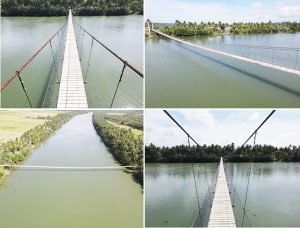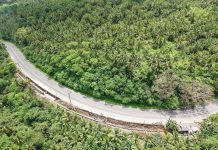CATARMAN, Northern Samar– Residents of Barangays Galutan and Doña Pulqueria, both this town, will no longer endure the danger of crossing the Catarman River, especially during the rainy season with the completion of the 175 linear meter hanging bridge implemented by DPWH-Northern Samar First DEO.
According to District Engineer Mario D. Villena, the total cost of the whole bridge project is P6.83 million and was constructed to put an end to the ordeal of the locals just to go to the other side of Catarman River.
The construction of the hanging bridge involves two phases. Phase I, amounting to P1.97-million involves the construction of a hanging bridge including portals, stairs with railings, grouted riprap and revetment while the P4.86 million Phase 2 includes the construction of 175 liner meter suspended bridge.
Other works comprise the installation of main cable (48mm 6×25 IWRC), 12 mm IWRC Suspender connected to wood planks, cyclone wire, stainless steel railings, and masonry painting for existing column.
Students from Doña Pulqueria and its neighboring sitios who attend classes at Galutan National High School, located on the other side of the river, now benefit from the new hanging bridge.
In an interview, Siara D. Alburo, a Grade 12 student, expressed her happiness with the completion of the said project as they will no longer use a boat or “sampan” in crossing the river just to access education.
“Every time po na naulan lalo na pag-bumabagyo, nahihirapan po kami tumawid kasi malakas ang agos ng tubig. So, pag wala kami baon hindi nalang kami umuuwi kasi wala kami pangkain at pamasahe, so pasalamat kami na meron ng hanging bridge kasi pag- maulan hindi na kami mahihirapan sa pagtawid at makakatipid na kami sa pamasahe kasi hindi na kami magbabayad sa bangka, dadaan nalang kami sa tulay para makapag-aral kami ng mabuti. Goal kasi naming na makapag-tapos sa pag-aaral para matulungan ang aming barangay”, Siara said.
District Engineer Mario D. Villena underscored that the newly-constructed hanging bridge will provide a safer and shorter route for students in going to their school. Locals can now experience easy travel to these remote areas.
(ANALIZA A. PABIA, PIO Alternate)




